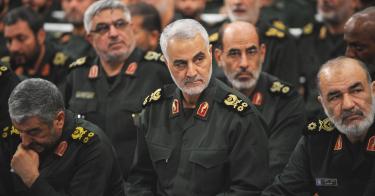Since the U.S. killed Iranian Maj. Gen. Qassem Suleimani in a drone strike on Jan. 2, talk has turned to whether the strike was legal if the general could not be proven to have posed an imminent threat.
But, as I said on Jan. 6 on Fox News and for the reasons explained below, the strike was legal, and that legality did not depend on an imminent attack about to be launched.
It’s an important question, and administration officials, as well as scholars and lawmakers from both sides of the aisle—see here, here, and here—have been talking as if it were a legal requirement that the general pose an imminent threat. But, based on the publicly available evidence, it wasn’t required under these circumstances.
As an aside, it seems that providing timely explanations for the legal basis for the killing of international terrorists has proven difficult for both Republican and Democratic administrations.
When Navy SEALS killed Osama bin Laden in 2011, the Obama administration did a terrible job explaining the underlying legal basis for the raid, which we tend to forget.
As I wrote about here, the Obama administration’s “pitiful and virtually non-existent legal defense of the mission is inexcusable and has given activists the opportunity to argue that the mission was unlawful.”
But the Obama administration was on solid legal ground when it killed bin Laden, as I wrote here. Officials eventually got their messaging right that the operation was perfectly legal, but not until after the armchair legal cognoscenti and international know-it-alls had piled on.
Today, commentators are piling on the Trump administration, claiming, among other things, that it failed to provide sufficient evidence that a future attack by Suleimani was imminent, or that the strike violated international law.
Administration officials only made it more difficult when they briefed Congress last week on the operation by providing conclusory evidence of what imminent attacks might take place.
Evidence of future attacks was no doubt based on highly sensitive sources and methods, which, if exposed, would cut off a critical pipeline of invaluable intelligence inside Iran. And since the administration was not willing to get into the details of how they knew future attacks were imminent, it gave some members of Congress the opportunity to call into question the value or weight of the evidence with respect to imminent threats, and gave some the politically convenient fig leaf to be able to say Suleimani was a bad guy, but, the administration failed to prove the threats were looming and immediate.
But as Attorney General Bill Barr said recently, the issue of imminence here is a “red herring.”
The United States sent a letter to the United Nations Security Council on Jan. 8 that said the targeted killing of Suleimani was an act of self-defense under Article 51 of the U.N. Charter. The letter, signed by U.S. Ambassador to the United Nations Kelly Craft, said the nation’s actions were “undertaken … in the exercise of its inherent right of self-defense.”
Craft’s letter cites previous armed attacks by Suleimani and his thugs, which include:
- Islamic Republic of Iran and Iran-supported militias of U.S. forces and interests in the Middle East
- The threat to the USS Boxer on July 18, 2019, while the ship was conducting a planned inbound transit of the Strait of Hormuz
- An armed attack on June 19, 2019, by an Iranian surface-to-air missile on an unmanned U.S. Navy MQ-4 surveillance aircraft on a routine mission monitoring the Strait of Hormuz in international airspace
- Attacks on commercial vessels off the port of Fujairah and in the Gulf of Oman that threaten freedom of navigation and the security of international commerce
- Missile and unmanned aircraft attacks on the territory of Saudi Arabia
- A series of attacks against U.S. forces in Iraq, including a series of indirect fire attacks targeting bases where U.S. forces are located
- A Dec 27, 2019, attack that killed a U.S. government contractor in Iraq and injured four U.S. service members
- Attacks against the U.S. embassy in Baghdad on Dec. 31, 2019, which resulted in significant damage to United States property
As the leader of the groups that launched these attacks during an ongoing armed conflict, Suleimani made himself a lawful military target against whom the United States could exercise its inherent right of self-defense.
It would be different if Suleimani had never directed any military attacks against the United States or if the United States were not in an ongoing armed conflict against al Qaeda, the Taliban, ISIS, and associated forces.
But we are. And Suleimani knew that and willingly joined the fight, just like other fighters from countries other than Iraq and Afghanistan. In doing so, he made himself a lawful military target.
But Suleimani’s actions go well beyond those listed in Ambassador Kelly’s letter. As the head of the ruthless Islamic Revolutionary Guard Corps, Suleimani directed, schemed, planned, and led attacks against the United States and its allies’ interests outside and inside the United States for decades.
>>>How US Strike Against Iranian General Changes Rules of Game in Iraq, Region
He traveled throughout the Middle East, in direct violation of a U.N. Security Council Resolution that specifically forbade him from travelling outside of Iran, and did so, no doubt, to brazenly continue his ongoing war against “the Great Satan” and our allies.
It simply defies common sense that the United States could not target him—lawfully, as a matter of self-defense—for his decades-long, ongoing military campaign against U.S. military and civilian personnel.
Beyond those listed in Ambassador Kelly’s letter, there are dozens of articles going back years that demonstrate that Iran—in particular, the Iranian Revolutionary Guard Corps, which Suleimani led—was directly or indirectly responsible for military actions against the U.S. military and other interests. They too make the case for using military force in self-defense, as one cannot willfully ignore Suleimani’s past actions.
Iran sought to expand its influence over Iraq long before the 2003 war in Iraq, as Heritage senior fellow and Iran expert Jim Phillips wrote in 2007. After the 1979 Islamic revolution, Iran’s new regime sought to subvert Iraq’s Sunni-dominated regime by radicalizing Iraq’s Shia majority, which (in 2007) was more than 60% of the Iraqi population.
As Phillips wrote, the elite Revolutionary Guards Special Forces unit, the Quds Force, “trains and equips a wide variety of Islamic militias and terrorist groups as part of Iran’s proxy war against the United States, Western countries, Israel, and moderate Middle Eastern governments.” Phillips detailed how the Quds force incited rebellion and chaos in Iraq.
In 2012, the Washington Post ran an article that said U.S. officials were concerned about Iran’s nuclear ambitions and the attempt to assassinate the Saudi ambassador to the United States in our country. That year, Iran ordered terrorist attacks on U.S. diplomats stationed in Azerbaijan and was prepared to launch terrorist attacks inside the United States.
As Phillips wrote here, the Quds Force “also supported attacks in Iraq by radical Shia militias and provided sophisticated explosive devices that killed many American soldiers in Iraq.”
The Defense Department’s most recent numbers indicate that the force Suleimani commanded was responsible for the deaths of at least 603 American soldiers in Iraq and Afghanistan.
The Revolutionary Guards also were responsible for the 1996 bombing of the Khobar Towers housing complex in Saudi Arabia, which killed 19 service members, and the 1983 bombing of the U.S. Marine barracks in Beirut, which killed 241 U.S. soldiers—although these attacks took place before Suleimani was in charge.
The list goes on, but there is no doubt the U.S. government has additional facts and intelligence that connect Suleimani and the forces and proxies he directed to deaths and attacks against the United States and our allies, both here and abroad.
And although we can’t predict what Suleimani had planned for his next terror campaign, the law does not require we do so to exercise our right of self-defense.
Suleimani was responsible for a decades-long series of military attacks against U.S. interests, which resulted in the deaths of at least 603 U.S. military personnel. There was no evidence he had withdrawn from his combatant activity and every indication that, if not stopped, his actions would be ongoing.
The United States had the legal right to exercise its inherent right of self-defense against him.
According to one legal expert in this area, Professor Robert Chesney, “imminence is a critical…concept that comes up in debates over self-defense. But it is not a necessary part of the analysis in all cases.”
The core case of self-defense, Chesney contends, “is not the situation in which an attack is merely imminent. … Instead, the core case for self-defense is a situation in which an attack has or is occurring already.”
He describes that scenario as “responsive self-defense,” which he notes is how the Ambassador Kelly letter to the U.N. framed the strike—“in response to an escalating series of armed attacks in recent months.”
Chesney argues, as I did above, that the possibility of future attacks “remains relevant in the responsive self-defense scenario.”
There is a substantive difference between responsive self-defense and anticipatory self-defense. The former does not require evidence of imminence; the latter does.
The United States was on solid legal grounds to act in self-defense and take out Suleimani. We had no legal obligation, under the circumstances, to demonstrate that future attacks were imminent.
This piece originally appeared in The Daily Signal




